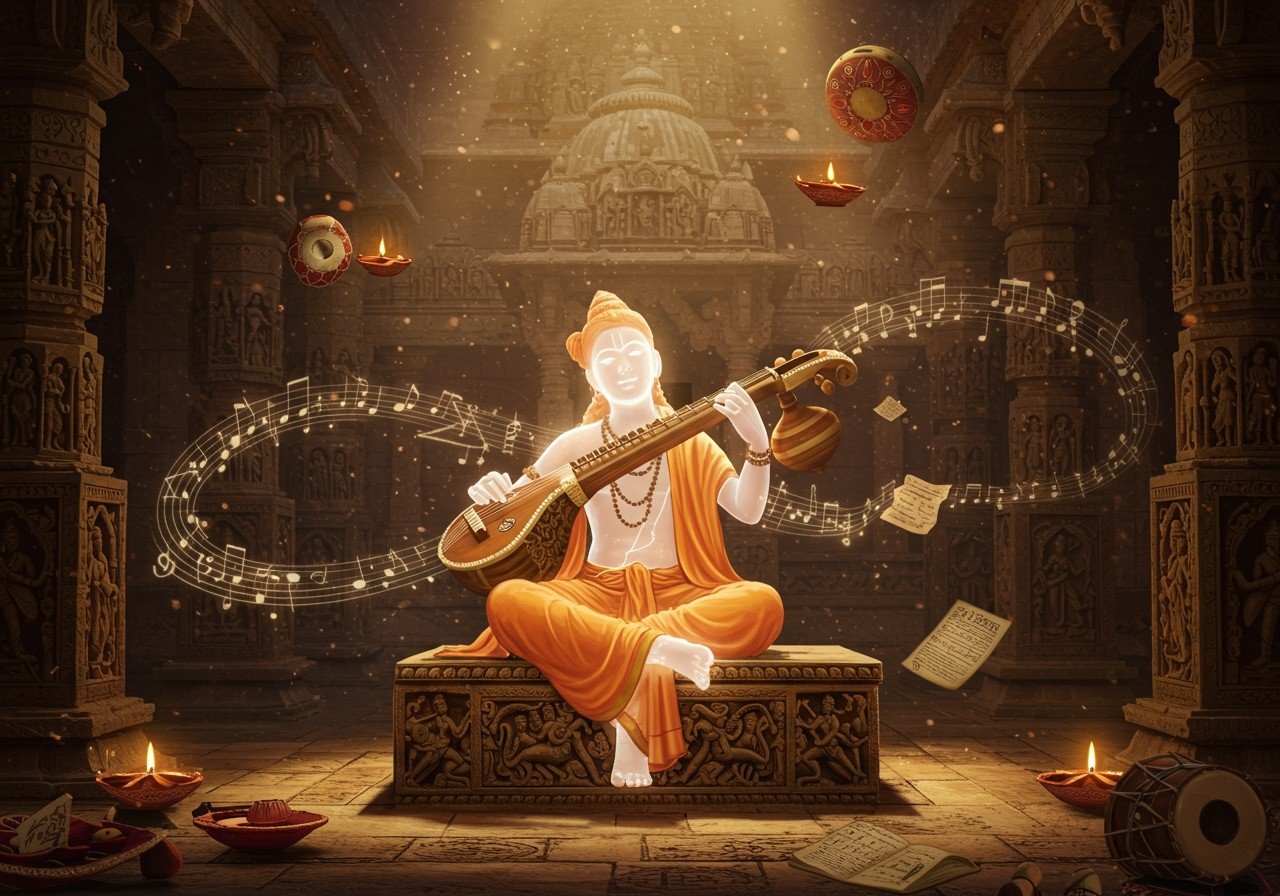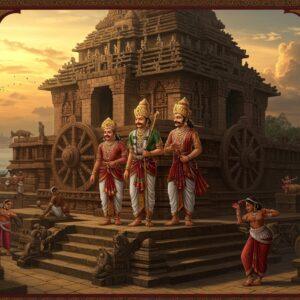
Embark on a melodic exploration of the life and works of Sripadaraja (1404–1502 AD), also known as Lakshminarayana Tirtha, a pivotal figure in Carnatic music history. A renowned Dvaita philosopher, scholar, and composer, he served as the pontiff of the Madhvacharya mutt at Mulbagal. Sripadaraja is widely recognized, alongside Narahari Tirtha, as a founder of the Haridasa movement, impacting both Carnatic and Hindustani music. This blog delves into his profound influence on the world of music and spirituality.
The Life and Contributions of Sripadaraja
Sripadaraja’s life, spanning from 1404 to 1502 AD, was a tapestry of devotion, scholarship, and musical innovation. Born Lakshminarayana, he embraced the path of a saint and became a revered guru, notably mentoring Purandara Dasa, the “father of Carnatic music.” He significantly propagated Dvaita philosophy and guided the Madhwa community. The Vijayanagara socio-political landscape of his era played a crucial role in shaping his compositions. Intertwined with the Bhakti movement, he shared connections with luminaries like Vyasatirtha, further enriching his spiritual and musical journey.
Exploring Sripadaraja’s Musical Compositions
Sripadaraja’s compositions, known as “krutigalu” or “keerthane,” are imbued with profound devotion, skillfully interweaving his deep reverence for Lord Vishnu. His music serves as a conduit for Dvaita philosophy, harmonizing spirituality and artistry. Many compositions center on the divine incarnations of Lord Vishnu, inviting listeners on a contemplative journey. A distinguishing characteristic of his work is its accessibility. By composing in Kannada, the local language of Karnataka, Sripadaraja departed from the tradition of using Sanskrit, thus democratizing his teachings and making them readily available to a wider audience, fostering a connection with intricate philosophical concepts through the medium of music.
Among his celebrated compositions, “Tunga Teera Vihara” stands out for its lyrical grace and evocative depiction of Lord Vishnu’s playful presence along the Tungabhadra River. This, along with other compositions like “Nana nanadana paahi,” “Ne ittahange iruveno hariye…,” “Kangalidyathako kaveri rangana nodada…,” “Bhushanake Bhushana,” “Akatakata samsaravanu,” and “Baro manege Govinda,” have become treasured gems in the Carnatic music repertoire. You can explore similar devotional items on Poojn.in, India’s largest cultural goods store.
Sripadaraja’s Musical Style and Innovations
Sripadaraja’s musical style is characterized by a harmonious blend of simplicity and profound depth. He is credited with pioneering the “suladi” structure, a unique musical form that seamlessly integrates various ragas and talas. His repertoire boasts an impressive collection of 133 suladis, showcasing his musical ingenuity and mastery over diverse forms. His compositions serve as a bridge between the earlier Prabandha styles and the contemporary kriti format. This innovative approach laid the groundwork for subsequent developments in Carnatic music, influencing generations of musicians. His strategic use of ragas and talas adds depth to the devotional aspect of his music, creating a listening experience that is both calming and uplifting. Discover related spiritual offerings at Poojn.in.
Influence and Legacy
Sripadaraja’s influence on Carnatic music is immeasurable. As a mentor to Purandara Dasa, he played a formative role in shaping the future of this musical tradition. Purandara Dasa, revered as the “father of Carnatic music,” structured the system as we know it today, building upon the foundations laid by Sripadaraja’s teachings. Sripadaraja’s impact extended far beyond his immediate disciples, inspiring numerous composers within the Haridasa tradition and leaving behind a rich legacy that continues to resonate. Through oral tradition and subsequent documentation, his compositions have transcended time, reaching modern audiences and retaining their relevance.
Sripadaraja’s Music School and its Impact
Sripadaraja’s establishment of a music school played a pivotal role in nurturing talent and propagating his musical and philosophical teachings. This institution embraced the traditional gurukula system, prioritizing personalized guidance and a holistic educational approach. Students received instruction in both musical skills and philosophical principles, ensuring a comprehensive learning experience. The school’s influence on Carnatic music and Dvaita philosophy remains significant, contributing to the preservation of these traditions for future generations. It fostered a nurturing environment where music and spirituality thrived in harmony.
Relevance in Contemporary Times
Sripadaraja’s legacy continues to flourish in the modern era. His compositions remain integral to Carnatic music concerts and festivals, captivating audiences with their timeless beauty and devotional depth. Musicians find inspiration in his work, constantly discovering new interpretations and presentations. In today’s digital age, technology plays a crucial role in preserving his musical heritage. Online platforms provide access to his compositions for a global audience, promoting cultural and spiritual values among the Indian diaspora. This accessibility ensures that the essence of his teachings remains alive for generations to come.
Poojn.in: Supporting Your Devotional Needs
Poojn.in, India’s largest online store for spiritual and cultural goods, offers a wide range of products relevant to Sripadaraja’s musical tradition. For those seeking to incorporate sacred musical elements into their worship, the Pancha Ratna set holds particular significance. Explore our diverse collection of devotional items, including murtis and other puja essentials. Srimad Bhagavad Gita is also available. Contact us at 03369029784 or WhatsApp us at 9476142738 for personalized guidance on incorporating these items into your devotional practices.
Frequently Asked Questions
What are the key themes in Sripadaraja’s music? Sripadaraja’s compositions predominantly explore themes of devotion, spirituality, and the teachings of Dvaita philosophy. These themes are beautifully intertwined with melodic charm, creating a listening experience that is both enriching and uplifting. His famous composition, “Nana nanadana paahi,” exemplifies this harmonious blend. His teachings resonated with people from all walks of life, making complex philosophical concepts accessible through the power of music. This approach established him as a key figure in bridging intellectual and spiritual understanding.
Where can I learn more about his compositions? Numerous resources offer insights into Sripadaraja’s musical contributions. Music libraries, online platforms specializing in classical Indian music, and dedicated educational institutions provide a wealth of information. You can find recordings, analyses, and historical context that delve into the nuances of his work. Additionally, several music schools offer specialized courses exploring his unique style and compositions, providing a structured way to learn and appreciate his musical genius.
Why is his musical heritage important? Sripadaraja’s musical legacy holds immense importance in preserving and promoting traditional Indian music and philosophy. His compositions continue to inspire and educate generations, offering valuable insights into Dvaita philosophy through the evocative medium of music. This preservation of cultural heritage ensures that his teachings and musical innovations continue to resonate with contemporary audiences. The accessibility of his work through online platforms and educational institutions further amplifies his impact, reaching a global audience and enriching the understanding of Indian classical music and spiritual traditions.
Conclusion
Sripadaraja’s enduring legacy stands as a testament to his devotion, creativity, and profound impact on Carnatic music. His compositions, rich in spiritual wisdom and artistic finesse, continue to inspire and uplift. Through his innovative musical style and dedication to making complex ideas accessible, he left an indelible mark on the Haridasa tradition. His role as a mentor and educator ensures that his teachings flourish through the ages. As modern technology brings his works to a global audience, his influence remains vibrant and relevant, connecting us with the timeless devotion and artistry that define our rich traditions.

